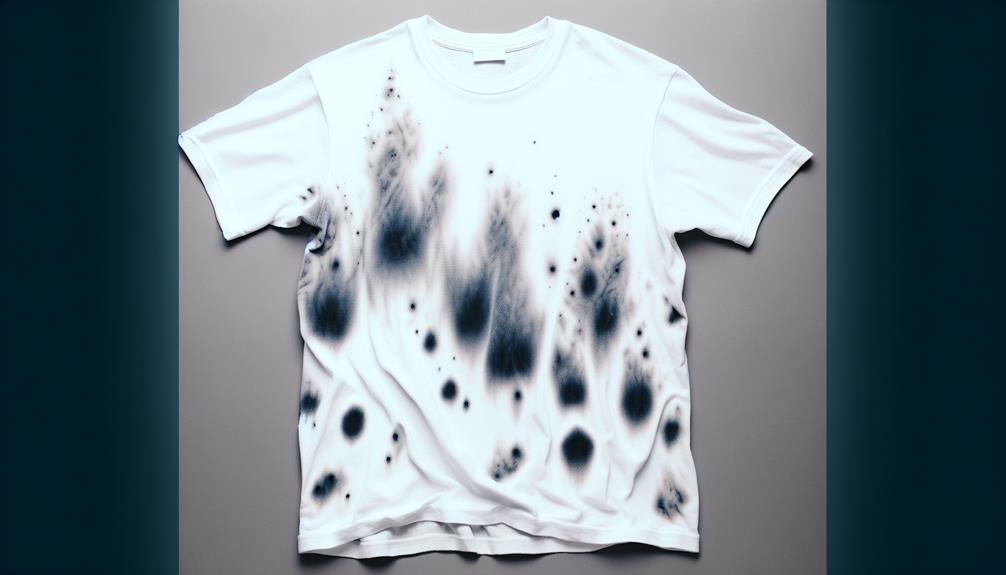Have you ever pulled freshly laundered clothes out of the washer only to find mysterious bleach spots scattered like constellations across your favorite shirt?
The culprit behind these frustrating splotches may not be as elusive as you think. From incorrect bleach dispensing to fabric sensitivity, there are several factors that can contribute to this laundry conundrum.
Let's unravel the mystery together and uncover the secrets of why bleach spots appear on clothes after a wash.
Table of Contents
Key Takeaways
- Improper bleach concentration can lead to bleach spots on clothes.
- Fabric sensitivity to bleach requires careful consideration for optimal garment care.
- Mixing bleach with incompatible chemicals can cause fabric damage and stains.
- Inadequate bleach handling and distribution can result in uneven bleach spots on clothes.
Incorrect Bleach Dispensing
When I forget to double-check the bleach dispenser before starting the laundry, bleach spots on my clothes become a common occurrence. Proper bleach dispenser maintenance is important to avoid this issue. Checking the bleach concentration levels and ensuring the dispenser is clean and functioning correctly are essential steps.
To prevent bleach spots, it's important to follow the manufacturer's instructions for proper bleach dispensing. This includes using the right amount of bleach and adding it to the designated compartment to prevent direct contact with clothes. Proper dispensing not only prevents bleach spots but also helps in fabric color protection.
Regularly cleaning the bleach dispenser is key to maintaining its functionality. Residue buildup in the dispenser can lead to uneven bleach distribution, resulting in spots on clothes. By incorporating these simple steps into my laundry routine, I can effectively address the issue of bleach spots on clothes caused by incorrect bleach dispensing.
Bleach Residue in Washer
To guarantee the longevity of my clothes and prevent bleach spots, addressing the issue of bleach residue in the washer is essential. Proper maintenance of the washing machine is important to avoid bleach residue buildup. Here are some key points to think about:
- Regular Cleaning: Wipe down the washer's interior regularly to remove any bleach residue that may have accumulated.
- Use Bleach Alternatives: Consider using alternatives like vinegar or baking soda to achieve the same cleaning effect without the risk of bleach residue.
- Run Cleaning Cycles: Periodically run the washer on a cleaning cycle with hot water and vinegar to eliminate any lingering bleach residue.
- Follow Manufacturer's Guidelines: Always follow the manufacturer's instructions regarding the use of bleach and other cleaning products to prevent residue buildup.
Mixing Bleach With Other Chemicals
Mixing bleach with other chemicals can create dangerous reactions that pose risks to both your health and the integrity of your clothes. To prevent harmful chemical reactions, it's important to be aware of the substances you are combining with bleach. Here are some safety precautions to keep in mind:
| Chemicals to Avoid Mixing With Bleach | Potential Risks |
|---|---|
| Ammonia | Releases toxic chloramine vapors |
| Vinegar | Produces chlorine gas, a respiratory irritant |
| Alcohol | Creates hydrochloric acid, a corrosive substance |
| Bleach-based Cleaners | Can lead to excessive chlorine exposure |
| Acids (e.g., Lemon Juice) | Releases chlorine gas, posing respiratory hazards |
Direct Contact With Bleach
Direct exposure to bleach can cause skin irritation and damage if proper precautions aren't taken. It's important to handle bleach carefully to prevent any harm.
Here are some key points to take into account regarding bleach exposure and fabric damage:
- Skin Protection: Always wear gloves and protective clothing when handling bleach to avoid direct contact with the skin.
- Proper Ventilation: Make sure the area is well-ventilated when using bleach to prevent inhaling harmful fumes.
- Avoid Mixing: Never mix bleach with other cleaning products as this can create dangerous chemical reactions.
- Quick Cleanup: In case of spills or splashes, rinse the affected area immediately to prevent fabric damage.
High Bleach Concentration
I've noticed that one common reason for bleach spots on clothes is using too much bleach. This can happen when we pour bleach directly onto the fabric instead of diluting it properly.
Also, applying bleach incorrectly, like accidentally splashing it on clothes, can lead to unwanted bleach stains.
Excessive Bleach Amount
In some cases, using a high concentration of bleach in the laundry can lead to the development of bleach spots on clothes after washing. This happens because the excess bleach may not completely rinse out, causing concentrated areas that can react with the fabric.
Here are some key points to take into account:
- Proper Measurement: Always follow the manufacturer's guidelines and use the recommended amount of bleach.
- Even Distribution: Make sure that the bleach is evenly distributed in the water before adding clothes to prevent concentrated bleach spots.
- Avoid Spillage: Clean any bleach spillage promptly to prevent direct contact with clothing.
- Monitor Discoloration: Keep an eye out for any bleach discoloration during the washing process to catch any issues early on.
Improper Bleach Dilution
Improperly diluted bleach can result in high concentrations that contribute to the formation of bleach spots on clothes after washing. When bleach is not properly diluted, its importance increases, leading to a higher risk of causing damage to fabrics. It is essential to follow manufacturer instructions for diluting bleach to make sure the right balance between effectiveness and safety. Additionally, considering fabric compatibility is vital to prevent bleach spots. Some fabrics are more sensitive to bleach than others, and using high concentrations on delicate fabrics can result in discoloration or weakening of the material. Below is a table outlining the impact of improper bleach dilution on fabric compatibility:
| Fabric Type | Effect of High Bleach Concentration |
|---|---|
| Cotton | Color fading and weakening fibers |
| Wool | Discoloration and damage |
| Silk | Yellowing and fabric deterioration |
| Polyester | Whitening and weakening |
| Rayon | Stiffening and discoloration |
Bleach Application Errors
To prevent bleach spots on clothes after washing, it's important to avoid using high concentrations of bleach during the application process. When it comes to bleach application techniques, using the right amount is essential. Here are some clothing maintenance tips to prevent bleach accidents and guarantee fabric care methods:
- Always dilute bleach according to the manufacturer's instructions.
- Test a small, inconspicuous area of the fabric before applying bleach.
- Consider using color-safe bleach alternatives for colored clothing.
- Store bleach away from direct sunlight and moisture to maintain its effectiveness.
Fabric Sensitivity to Bleach
I've noticed that different fabrics react uniquely to bleach, which can lead to unexpected outcomes like bleach spots on clothes. To make certain this, understand which fabrics are sensitive to bleach and adjust your laundry routine accordingly.
I'll share some helpful fabric care tips to make certain your clothes remain vibrant and free from bleach stains.
Bleach and Fabric Reaction
When using bleach on clothes, some fabrics may exhibit sensitivity to the chemical resulting in bleach spots after washing. This sensitivity is often due to the fabric's composition and how it reacts with the bleach.
Here are some key points to take into account:
- Fabric Type: Different fabrics react differently to bleach, with some being more prone to discoloration than others.
- Dye Stability: Fabrics with unstable dyes are more likely to experience color changes when exposed to bleach.
- Fiber Structure: The structure of the fabric's fibers can impact how they interact with bleach and whether they're prone to damage.
- Bleach Concentration: Higher concentrations of bleach can increase the likelihood of fabric discoloration and damage.
Avoiding Bleach Stains
Considering fabric sensitivity to bleach, it's important to take precautions to prevent bleach stains on clothes.
To safeguard your garments, prioritize color protection by separating whites from colored items before laundering. Opt for fabric selection based on bleach sensitivity; natural fibers like cotton are more resistant to bleach than synthetic materials.
When in doubt, perform a bleach sensitivity test on a small, inconspicuous area of the fabric before full application. By being mindful of fabric reactions to bleach, you can prolong the life of your clothes and avoid unsightly bleach spots.
Fabric Care Tips
To guarantee your clothes remain free from bleach spots, it's important to comprehend the fabric sensitivity to bleach and adopt appropriate fabric care tips. Understanding how different fabrics react to bleach can help prevent unwanted stains and damage.
Here are some key fabric care tips to keep in mind:
- Check Fabric Labels: Always read the care labels to see if the fabric can withstand bleach.
- Spot Test Before Use: Prior to using bleach for stain removal, test it on a small, inconspicuous area to make certain the fabric won't be damaged.
- Use Color-Safe Bleach: Opt for color-safe bleach to protect colored fabrics from discoloration.
- Wash Separately if Needed: If you need to use bleach, wash the bleachable items separately to avoid accidental contact with non-bleachable fabrics.
Frequently Asked Questions
Can Using Too Much Bleach in One Load of Laundry Cause Bleach Spots on Clothes?
Using too much bleach in one laundry load can indeed cause bleach spots on clothes. It's important to dilute bleach properly based on fabric type and color to avoid damaging garments. Overuse can lead to irreversible discoloration.
Are There Any Ways to Prevent Bleach Residue From Building up in the Washer and Transferring Onto Clothes?
To prevent bleach residue from transferring onto clothes, I dilute bleach properly, follow fabric care guidelines, and regularly clean the washer. Diluting bleach guarantees it won't damage fabrics, while proper care maintains clothing quality.
What Happens if Bleach Is Mixed With Other Chemicals in the Laundry Process?
Mixing bleach with other chemicals in laundry can cause dangerous chemical reactions leading to color fading, fabric damage, and difficulty in stain removal. It's important to follow safety guidelines and never combine bleach with other cleaning agents.
Can Direct Contact With Bleach on Clothes Cause Bleach Spots Even After Washing?
Direct contact with bleach on clothes can cause bleach spots even after washing. Fabric composition and dye reactions, along with water temperature and wash cycles, play essential roles. Understanding these factors can help prevent unwanted discoloration.
How Does Fabric Sensitivity to Bleach Play a Role in Causing Bleach Spots on Clothes?
Fabric composition and sensitivity are critical in preventing bleach spots. I've found that understanding which fabrics can withstand bleach helps avoid mishaps. Following proper laundering tips for delicate fabrics is key to keeping clothes spotless.
- Innovations in Moisture-Wicking Textiles - July 18, 2024
- Engineering Fabrics for Optimal Performance - July 18, 2024
- The Science of Breathability in Fabrics - July 18, 2024






